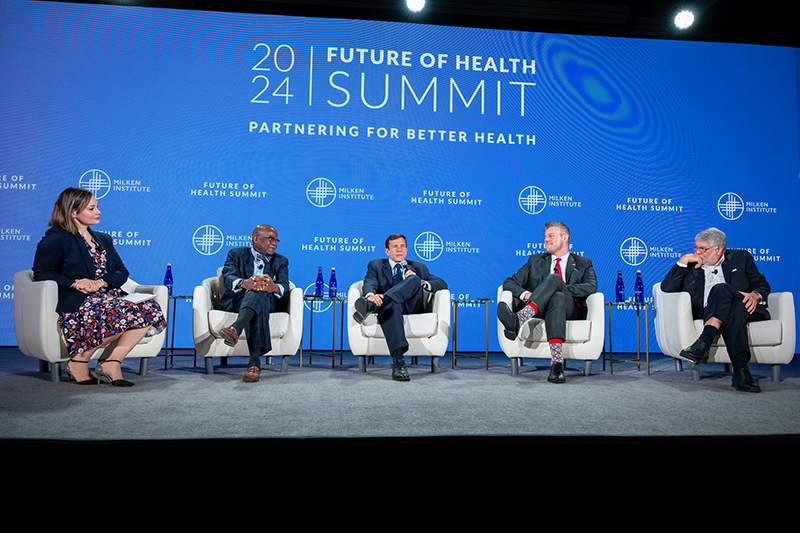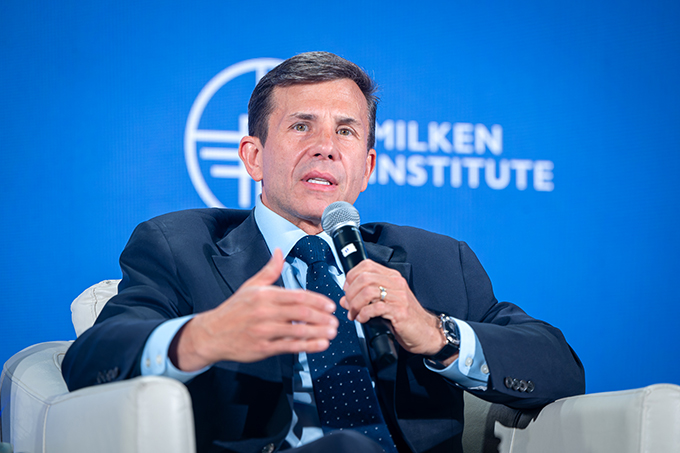As biotech breakthroughs enable remarkable advances in treatment and prevention of disease, we need similar levels of innovation in access, so patients benefit from these breakthroughs, John F. Crowley, President & CEO of the Biotechnology Innovation Organization (BIO), told the Milken Institute’s Future of Health Summit.
During a Nov. 13 panel, “Partnerships Leading to a Healthier Tomorrow,” at the think tank’s prestigious annual gathering in Washington, Crowley introduced himself by explaining why he cares so much about biotech: “My journey started in the late 1990s when our two youngest children were diagnosed with a rare form of muscular dystrophy known as Pompe disease. It launched me into this world of science and medicine.”
Going from the personal to the global, Crowley reminded the panel why everyone cares about biotechnology.
“Of course we care for the public health—the potential to control, to prevent disease, to alleviate an enormous amount of human suffering around the world. We care about it for economic security, a productive and healthy workforce, but it’s also a matter of national security,” Crowley said.
“The ability to make newer and better medicines to prevent disease in the first place is a matter of national security,” he explained. “It is a strategic asset to the United States and our allies, and ultimately the entire world.”
To guide BIO’s work in supporting biotech, Crowley said he focuses on seven strategic priorities, with two top priorities being greater innovation and access.
Innovation
“So when we think about innovation, we’ve traditionally thought about the development of biotechnology in kind of neat swim lanes, if you will. We’ve got science here, medicine regulation, patient interest,” Crowley said. “And what we realize is it’s actually a circle—what I like to describe as a virtuous circle, where you’ve got the patient, the person, the consumer in the middle and the heart and soul of everything.”
Crowley mentioned another session held at the summit earlier that day, during which Food and Drug Administration (FDA) Commissioner Robert Califf, M.D., said this is a great time for biotech innovation.
“Doctor Califf was right. I’ve never been more excited about the science and medicine,” said Crowley, adding that we must enable that innovation. “The science and medicine is here. We just need to make sure we’ve got an infrastructure and ecosystem that helps us, in some ways, get out of our own way.”
Supporting the innovation ecosystem requires a resilient supply chain, capital for investment, and intellectual property protection, he added. It also means we must “reimagine the clinical trial and FDA approval and review process,” Crowley said.
He noted that FDA’s Califf has supported changes like improving regulatory science while keeping to the gold standard, as well as proposals to benefit from “Bayesian statistics, adaptive study design, and looking at each drug through a separate risk-benefit assessment.”
Access
Innovative breakthroughs in biotech only have value if they reach patients, which is why we also need innovation in access, Crowley said.
“Simply making new or better medicines is necessary but not sufficient,” he said. “Janet Woodcock at FDA years ago said that until we get to the point where the homeless person living under a bridge has access to the most state-of-the-art CAR T cancer therapies, we will have failed.”
There’s still a lot of work needed to tear down economic barriers to accessing medicines, according to Crowley.
“We’ve got to the point where in many cases now, with these complex and cumbersome utilization management practices at many insurance companies, a physician writes a script and it’s a recommendation at the insurance company,” Crowley said. “We’ve kind of broken that sacred bond” between doctor and patient.
A big part of the problem is the “Byzantine system,” where only about half the revenue from a medicine goes to the innovators and drug developers, according to Crowley.
“The rest of it is lost in the system,” he said. “You’ve got the PBM’s [pharmacy benefit managers] and wholesalers, and pharmacies. We need transparency in that. We need to delink any of those intermediaries from this massive perverse disincentive that the higher the price of medicine, the better it is for the middle men.”
When it comes to the broad reform necessary for better access, Crowley spoke of a “vision” for improvement.
“President Obama signed into law the 21st Century Cures Act eight years ago. We need a 21st century Access Act—reimagined co-pays, out of pocket costs, the whole system,” he said. Reform should remove economic and educational barriers to medicine, improving women’s healthcare and care for disenfranchised communities, Crowley explained.
Agriculture and prevention
When it comes to preventing disease, biotech companies also play a role in promoting good nutrition through agricultural biotech, said the panel’s moderator, CNN Medical Correspondent Meg Tirrell.
Crowley agreed, adding that food security is another one of his strategic priorities. He cited an example of biotech improving food security.
“About 40% of the apples that we grow and distribute here in the United States get thrown away because they go brown, they go rotten,” Crowley said. “There is now a remarkable and safe biotechnology from one of our thousand member companies in the agriculture space that prevents browning of apples.”
He noted the advantages of reduced waste, saying an innovation like longer-lasting apples helps cut the cost of school lunches for children while providing them healthy nutrition.
Beyond good diet, prevention can also involve a good prescription medicine, such as statins, which prevent cardiovascular disease, Crowley said.
Given the potential of medicines, we can do a lot to prevent future illness by encouraging the ongoing biotech revolution, he added.
“We really are now just coming into the dawn of the golden age of medicine, where there are so many technologies that have the ability to change human health, whether it be prevention, control, cure,” according to Crowley.
“But we keep getting in our own way,” with obstacles ranging from regulatory paradigms to challenges with manufacturing, clinical trials and paying for new drug development, he said. “Let’s just make sure we get out of our own way in some cases.”





